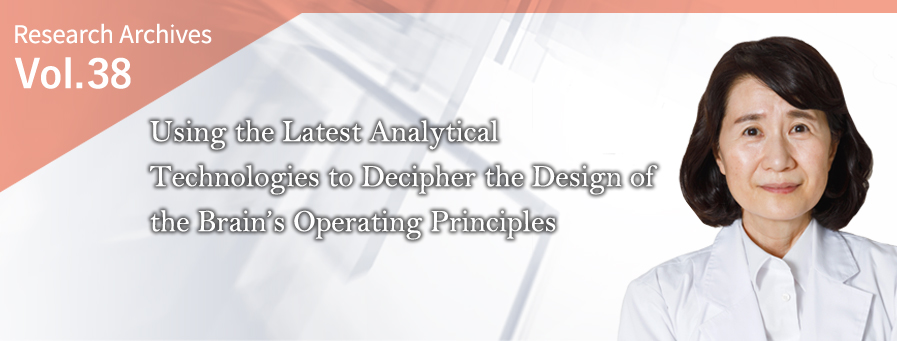
Department of Histology and Cytology, Graduate School of Medicine, Hokkaido University
Fumino Fujiyama M.D., Ph.D.Physiological Science
- [Academic & Professional Experience]
-
- 1987 : Resident
Internal Medicine and Neurology, Saga Medical School - 1991 : Board certified member
Japanese Society of Internal Medicine - 1992 : Research Assistant
Department of Anatomy, Saga Medical School - 1993 : Board of clinical neurology
Japanese Society of Neurology - 1993 : Fellow
Japanese Society of Internal Medicine - 1996 : MD, PhD
- 1997 : Post-doctoral scientist
MRC, Oxford University - 1999 : Visiting assistant professor
University of Tennessee - 2000 : Research Associate
Kyoto University, Graduate School of Medicine - 2004 : Lecturer
Kyoto University, Graduate School of Medicine - 2005 : Associate Professor
Kyoto University, Graduate School of Medicine - 2012 : Professor
Doshisha University, Graduate School of Brain Science - 2020 : Professor
Hokkaido University, Faculty of Medicine and Graduate School of Medicine
- 1987 : Resident
Research to clarify the wiring diagram of neurons in the brain
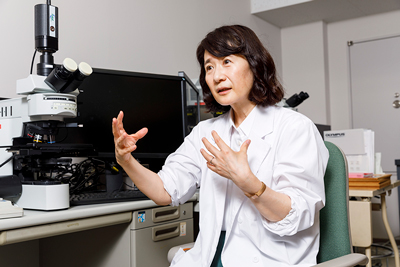
The Department of Histology and Cytology is a historic department with its roots in Anatomy III, which was established when the Hokkaido University School of Medicine was first established. In 2020, Professor Toshihiko Iwanaga, who was responsible for the department, retired and Professor Fumino Fujiyama was appointed as his successor. In addition to Professor Fujiyama, whose primary research focus is on central nervous circuits, Associate Professor Hiromi Iwanaga and Lecturer Junko Kobayashi have been part of the department since Professor Toshihiko Iwanaga’s tenure. Associate Professor Iwanaga works on mechanoreceptors that detect rodent whisker movement and teeth meshing, while Lecturer Kobayashi conducts research on the functional morphology of sugar chains and lectins.
“In my clinical practice as a neurologist, I began to wonder why patients with Parkinson’s disease and Huntington’s chorea have difficulty moving as they wish. Conversely, the question we should be asking is, ‘Why are we able to move as we wish?’ I entered the field of basic research to answer this question,” says Professor Fujiyama.
Dopamine neurons, which cause Parkinson’s disease, control not only motor functions but also higher brain functions such as reward-based reinforcement learning. However, the neural circuits of the brain are extremely complex, with all of the elements including sensation, movement, cognition, and emotion functioning while simultaneously influencing each other, making it difficult to grasp the overall picture of the brain and decipher the design that serves as the operating principle.
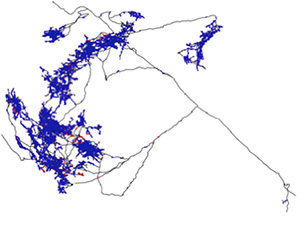
The catalyst that brought about a breakthrough was the fusion of advanced analytical technologies and experimental methods. The introduction of the latest technologies, such as specific neuronal labeling using a recombinant viral vector, neural reconstruction using confocal laser microscopy and neurolucida, and patch clamping combined with optogenetics, have led to groundbreaking results. One of these is the completely visualized axons of single neurons using a recombinant viral vector. By infecting a single neuron with a recombinant viral vector that incorporates a membrane targeting signal and fully visualizing the projecting axon, we became the first in the world to clarify where neurons in the patch (striosome) region, which are irregularly distributed in the striatum, project.
Professor Fujiyama says, “This is something I had been curious about since my clinical days, and I was incredibly surprised when I discovered that the axon has a completely different shape from the axon conventionally imagined. If you look at the brain as a whole, it is a network of tens of billions of complex neurons connected to each other. The goal of our research group is to decipher every nook and cranny of the brain’s neuronal wiring diagram and to understand the mechanisms of neural circuits related to various brain and mental disorders. While it is a lofty goal, I think it is a fascinating field that stimulates the spirit of researchers.”
Working with national and international collaborators to advance neuroscience
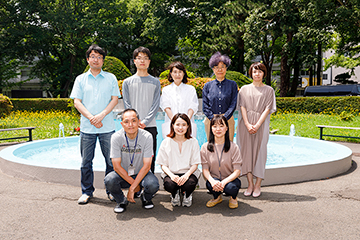
“Morphology and other static approaches have the advantage of being able to pursue precision. By combining this with dynamic approaches such as electrophysiology and optogenetics, we believe we can comprehensively elucidate a fundamental image of the brain. Based on the accurate maps thus obtained, we hope to contribute to the elucidation of the pathology and therapeutic application of neurodegenerative diseases in which specific neuronal systems are damaged,” says Professor Fujiyama.
As a planning group receiving a Grant-in-Aid for Transformative Research Areas (A) ‘Cell type census of adaptive neuronal circuits: biological mechanisms of structural and functional organization (Adaptive Circuit Census, ACC)’ in FY 2021 and as part of a four-country group selected for a HFSP Research Grant in 2022, they are working to further develop their national and international collaborations.
Graduate student Fuko Kadono is also enrolled in the Graduate Course: Developmental Brain Science (DBS) at the Research and Education Center for Brain Science, along with the doctoral program at the Graduate School of Medicine, where she is experiencing systematic lectures and practical training, and is elucidating the special neural regions in the basal ganglia and their input/output, a theme she has been pursuing since her master’s program.
“There is a specific structure in the striatum of the cortex-basal ganglia-thalamus loop. I am working to elucidate the mechanisms related to the input/output of two types of cells with acceleration and braking functions. I became fascinated in research on the nervous system at university and chose Professor Fujiyama’s laboratory because I wanted to know how far I could go to figure it out. I am committed to giving it my all in this department until I achieve satisfactory results,” says Kadono.
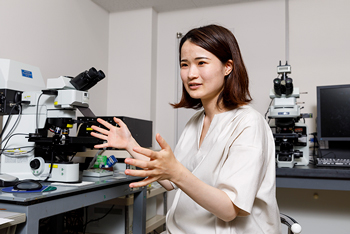
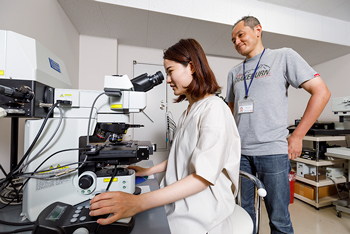
“It may have seemed reckless for me to make the jump from clinician to the world of basic research and to study freely at universities and research institutions both in Japan and abroad. However, I feel that the appeal of a research career is that you are free to work on what you want to know. This is why I want to provide an environment where young people can freely and spontaneously engage in research,” says Professor Fujiyama, who is committed to supporting young researchers like Kadono.
(Interview conducted in July 2022)
Seminar to exchange information with world-class researchers
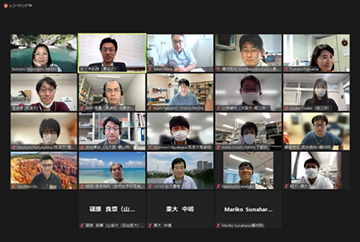
Professor Fujiyama says that during her time at Oxford University, Kyoto University, and Doshisha University research institutes, discussions with members of her research group were part of the daily routine. In fact, the group studying the central nervous system still holds weekly face-to-face meetings. In addition, online seminars are held bi-weekly for the team chosen by the Ministry of Education, Culture, Sports, Science and Technology for the Grant-in-Aid for Transformative Research Areas. The seminars provide an extremely fruitful opportunity for top runners in Japan to gather together and exchange information on cutting-edge topics.


